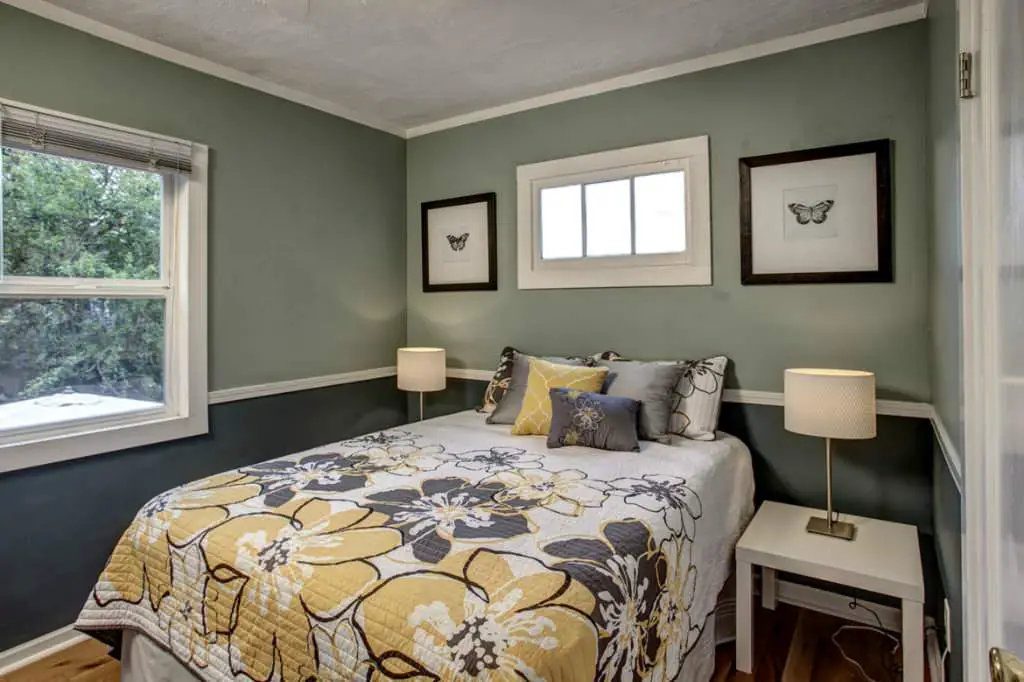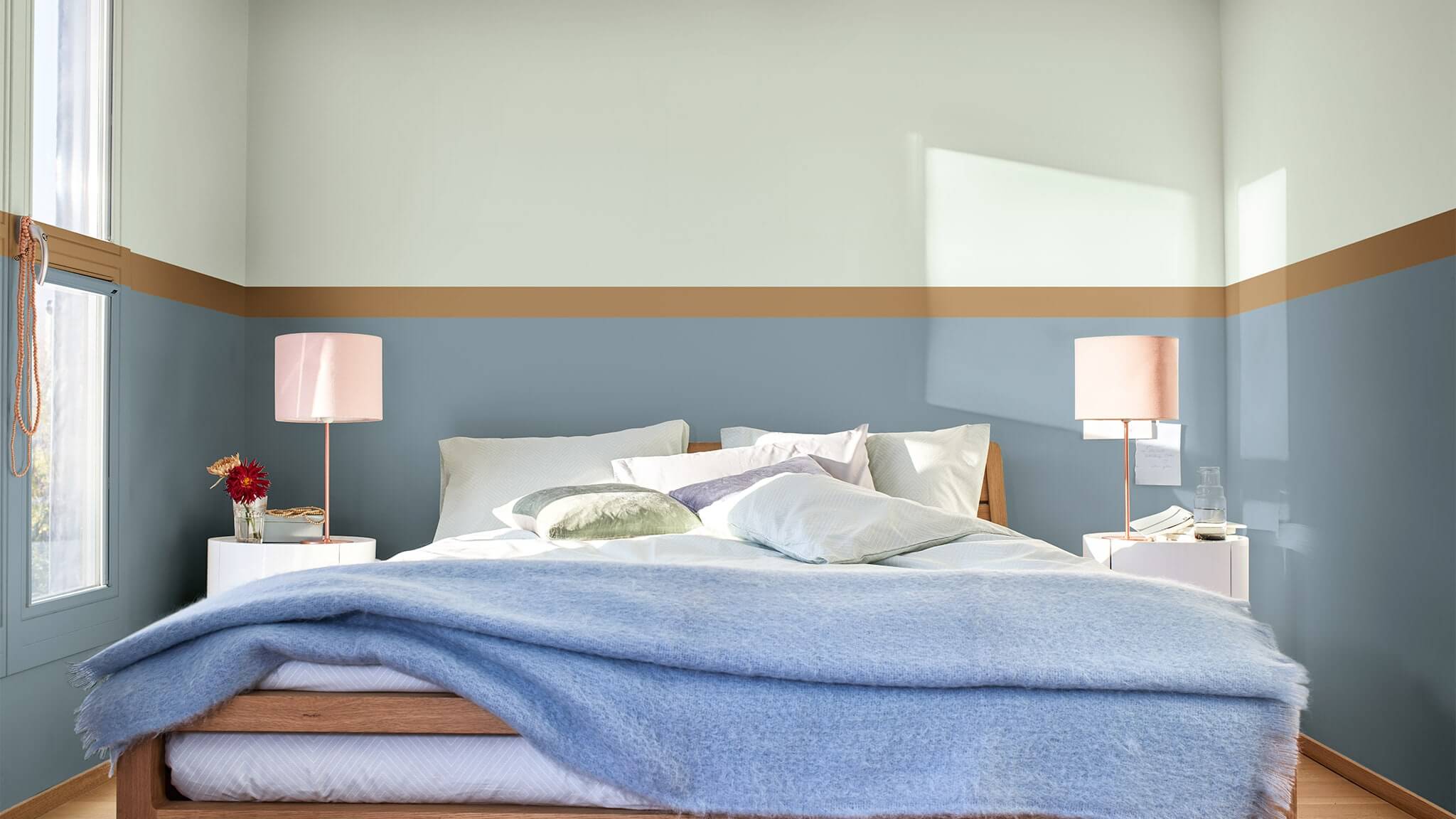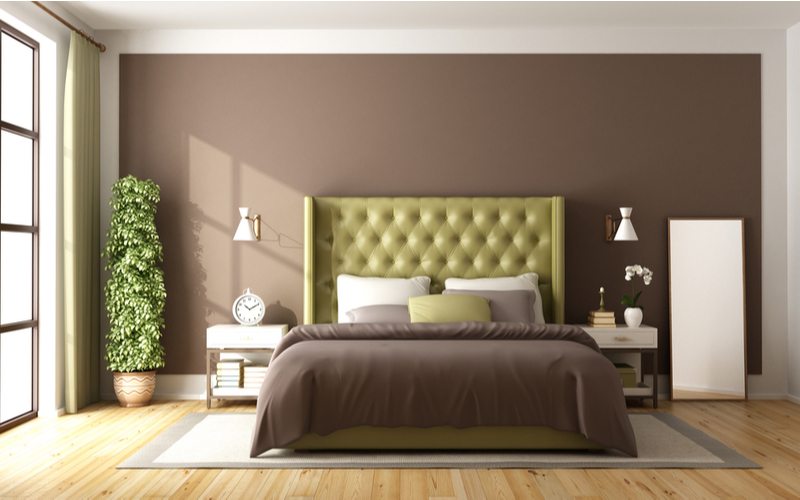Understanding Two-Tone Bedroom Color Schemes

Two-tone color schemes, a popular design technique, involve using two distinct colors to create a visually appealing and harmonious space. This approach allows for a balanced and sophisticated aesthetic, adding depth and dimension to the room.
Benefits of Two-Tone Color Schemes in Bedrooms
Using two-tone colors in bedrooms offers several advantages:
– Creating Visual Interest: Two-tone color schemes add visual interest and break the monotony of using a single color. The contrast between the two colors adds depth and dimension to the room, making it more engaging and dynamic.
– Defining Space: By using different colors on walls, furniture, or accessories, you can define different areas within the bedroom. For example, you can use a darker color on the accent wall behind the bed to create a focal point or use a lighter color on the ceiling to make the room feel more spacious.
– Setting the Mood: Color plays a significant role in setting the mood of a space. Choosing the right color combination can create a relaxing and calming atmosphere, a vibrant and energetic space, or a sophisticated and elegant feel.
– Flexibility and Versatility: Two-tone color schemes offer flexibility in creating different looks and styles. You can easily change the overall feel of the room by simply switching out accessories or artwork that complement the chosen colors.
Popular Two-Tone Color Combinations for Bedrooms
Here are some popular two-tone color combinations that work well in bedrooms:
– Neutral and Accent Color: This classic combination involves using a neutral base color like white, gray, or beige and pairing it with a bolder accent color. This approach allows you to add a pop of color without overwhelming the space.
– Complementary Colors: Complementary colors are opposite each other on the color wheel, such as blue and orange, red and green, or yellow and purple. Using these colors together creates a vibrant and energetic feel.
– Analogous Colors: Analogous colors are located next to each other on the color wheel, such as blue, blue-green, and green. These combinations create a harmonious and cohesive look.
– Monochromatic Colors: Monochromatic color schemes use different shades, tints, and tones of the same color. This creates a sophisticated and elegant feel.
Examples of Two-Tone Color Combinations
The following table showcases examples of two-tone color combinations for bedrooms, along with their associated mood, style, and a description of an example image:
| Color Combination | Mood | Style | Example Image Description |
|---|---|---|---|
| White and Navy Blue | Calm, sophisticated | Modern, nautical | A bedroom with white walls and navy blue bedding, featuring a large window with natural light streaming in. The room has a minimalist aesthetic with a few carefully selected pieces of furniture. |
| Gray and Teal | Serene, tranquil | Contemporary, coastal | A bedroom with light gray walls and teal accents, including a teal headboard, throw pillows, and a rug. The room has a calming and inviting atmosphere with natural wood elements. |
| Beige and Coral | Warm, inviting | Bohemian, eclectic | A bedroom with beige walls and coral accents, including a coral throw blanket, artwork, and a statement lamp. The room has a bohemian vibe with textured fabrics and plants. |
| Pale Pink and Sage Green | Romantic, feminine | Cottagecore, vintage | A bedroom with pale pink walls and sage green accents, including a sage green headboard, curtains, and a vintage rug. The room has a romantic and charming feel with floral patterns and antique furniture. |
Choosing the Right Colors

Creating a two-tone bedroom color scheme involves selecting the perfect pair of colors to set the mood and style you desire. This involves carefully considering personal preferences, the room’s size, and the amount of natural light it receives.
Factors to Consider When Choosing Colors
Understanding the factors that influence color choices is crucial for achieving the desired ambiance.
- Personal Preferences: The foundation of any color scheme is personal preference. Choose colors that evoke positive emotions and create a sense of comfort and relaxation. If you enjoy vibrant hues, a bold accent wall against a neutral backdrop might be ideal. Conversely, if you prefer a serene and calming space, softer tones like pale blues or greens can be used.
- Room Size: Color can visually alter the perception of space. Lighter colors can make a small bedroom appear larger, while darker colors can create a cozy and intimate atmosphere in a larger space.
- Natural Light: The amount of natural light a room receives impacts how colors appear. Rooms with abundant natural light can handle bolder color combinations, while rooms with less natural light might benefit from lighter, brighter tones to prevent a gloomy feel.
Designing a Two-Tone Bedroom Color Scheme Based on a Specific Mood or Style
Color psychology plays a crucial role in creating a desired atmosphere. For example:
- Relaxing and Serene: Consider a combination of soft blues and grays, or pale greens and creams. These colors promote tranquility and calmness, ideal for creating a restful environment.
- Energetic and Vibrant: A combination of bold yellows and oranges can inject energy and enthusiasm into a space. This scheme is perfect for those who want a stimulating and lively bedroom.
- Sophisticated and Elegant: A combination of deep navy blues and warm golds can create a luxurious and sophisticated feel. This scheme is suitable for those who prefer a more formal and refined bedroom.
Using Color Psychology to Create a Desired Atmosphere
Color psychology plays a crucial role in setting the mood and atmosphere of a space. Understanding the psychological effects of different colors can help you create a bedroom that promotes relaxation, inspires creativity, or enhances your mood.
Blue: Often associated with calmness, serenity, and tranquility. It can promote relaxation and sleep.
Green: Represents nature, growth, and harmony. It can create a sense of peace and tranquility.
Yellow: Known for its uplifting and cheerful qualities. It can stimulate creativity and optimism.
Red: Associated with energy, passion, and excitement. It can create a stimulating and invigorating atmosphere.
Purple: Represents royalty, luxury, and spirituality. It can evoke feelings of calmness and creativity.
Applying Two-Tone Colors in the Bedroom: 2 Tone Bedroom Colors

A two-tone color scheme can transform your bedroom into a visually appealing and inviting space. This technique involves using two colors to create contrast and depth, adding personality and style to your sanctuary.
Methods for Incorporating Two-Tone Colors
There are numerous ways to incorporate two-tone colors in your bedroom. You can create a dramatic effect by painting the walls in two different colors, using furniture in contrasting hues, or adding accessories that complement the chosen palette.
Painting the Walls
Painting the walls in two different colors is a popular method for creating a two-tone effect. This can be achieved by painting the entire room in one color and using a contrasting color for an accent wall, or by dividing the wall horizontally or vertically using two different colors.
Using Furniture
Furniture can play a significant role in a two-tone color scheme. You can select furniture pieces in a contrasting color to the walls or choose furniture with upholstery that complements the accent wall color. For example, a white bed frame can be paired with a dark gray accent wall, or a navy blue sofa can complement a light blue wall.
Adding Accessories
Accessories such as throw pillows, curtains, rugs, and artwork can be used to introduce pops of color and enhance the two-tone scheme. These accessories can be in the same color family as the accent wall or offer a contrasting hue to create a more dynamic look.
Step-by-Step Guide to Painting a Bedroom Using a Two-Tone Color Scheme, 2 tone bedroom colors
Painting your bedroom with a two-tone color scheme can be a rewarding project. Here is a step-by-step guide to help you achieve a professional finish:
1. Choose your colors. Select two colors that complement each other and create the desired ambiance. Consider the size and layout of your bedroom when choosing colors.
2. Prepare the walls. Before you begin painting, make sure to prepare the walls by cleaning them and patching any holes or cracks.
3. Decide on the color placement. Determine where you want to place the accent wall. You can choose to paint the entire room in one color and use the other color for an accent wall, or you can divide the wall horizontally or vertically using two different colors.
4. Tape off the areas. If you are using a horizontal or vertical division, use painter’s tape to create a clean line between the two colors.
5. Paint the accent wall. Begin by painting the accent wall. Apply two coats of paint for optimal coverage.
6. Paint the remaining walls. Once the accent wall is dry, paint the remaining walls in the other color.
7. Remove the tape. After the paint has dried, carefully remove the painter’s tape to reveal a clean line between the two colors.
Visual Representation of a Two-Tone Bedroom Design
Imagine a spacious bedroom with soft, calming colors. The walls are painted in a light, airy shade of pale blue, creating a sense of tranquility. One wall, behind the bed, is painted in a deeper shade of navy blue, adding a touch of sophistication and drama.
The bed frame is a simple, modern design in white, contrasting beautifully with the navy blue accent wall. The bedding is a crisp white with a navy blue throw pillow, echoing the color scheme.
The floor is covered in a light gray rug with a subtle geometric pattern, adding visual interest without overpowering the room. The windows are dressed with white linen curtains that filter the sunlight, creating a soft, diffused glow.
A small, round table sits next to the bed, adorned with a silver lamp and a stack of books with colorful covers. A large piece of artwork with abstract lines in shades of blue and white hangs above the bed, adding a touch of modern art to the space.
Comparing and Contrasting Different Approaches to Applying Two-Tone Colors
There are various approaches to applying two-tone colors in a bedroom. Some prefer to use contrasting colors for a dramatic effect, while others opt for more subtle color combinations to create a cohesive and calming atmosphere.
For example, a bedroom with a bright yellow accent wall and white walls might create a lively and energetic vibe, while a bedroom with a light gray accent wall and a slightly darker gray for the remaining walls might create a more subdued and sophisticated feel.
Ultimately, the best approach to applying two-tone colors depends on your personal preferences and the overall design aesthetic you wish to achieve.
